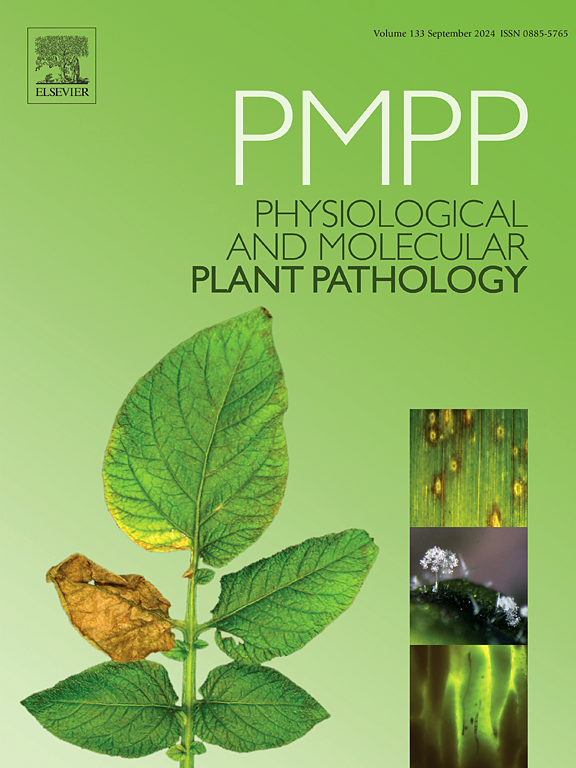CPI-SMEL: A novel antibacterial and nematicidal peptide from Solanum melongena characterized as a carboxypeptidase inhibitor
IF 2.8
3区 农林科学
Q2 PLANT SCIENCES
引用次数: 0
Abstract
Solanaceae plants are rich sources of antimicrobial peptides (AMPs), offering considerable potential for the discovery of novel molecules to address sustainable plant pathogen control strategies. Among them, Solanum melongena, commonly known as eggplant, has emerged as a promising candidate, with peptide extracts exhibiting potent antimicrobial properties. This study aims to identify and characterize a potent new AMP isolated from aqueous extracts of Solanum melongena 'Florida Market' leaves. The peptide isolation process commenced with the extraction of eggplant leaf material, followed by selective heating. Subsequently, the extract underwent ammonium sulfate precipitation and ultrafiltration to concentrate the peptide fraction. Chromatographic purification was performed using a combination of ion exchange, size exclusion, and reversed-phase HPLC techniques to achieve high purity level. The obtained fractions were analyzed using SDS-Tricine-PAGE. Peptide identification was accomplished using LC-MS/MS and automated Edman sequencing. Additionally, comprehensive bioinformatics analyses were conducted, including conservation, phylogeny, three-dimensional structure modeling, and molecular dynamics simulations, to provide insights into the peptide structure and function. The purified peptide, named CPI-SMEL, with 4.156 Da, was characterized as a carboxypeptidase inhibitor (CPI), demonstrating significant antimicrobial activity and structural stability. Evaluation against the plant pathogenic bacteria Ralstonia solanacearum and Clavibacter michiganensis subsp. michiganensis, as well as the root-knot nematode Meloidogyne incognita, revealed strong antimicrobial efficacy of two eggplant peptide extracts Pool1 and PC1. The characterization of CPI-SMEL underscores the potential of CPIs in the development of safe and sustainable plant defenses, highlighting eggplant and other Solanaceae species as promising sources of AMPs for effective plant pathogen management.
CPI-SMEL:一种新型抗菌和杀线虫肽,从茄龙葵中提取,具有羧基肽酶抑制剂的特征
茄科植物是抗菌肽(AMPs)的丰富来源,为发现新的分子来解决可持续的植物病原体控制策略提供了巨大的潜力。其中,茄(Solanum melongena),俗称茄子,已成为一个有希望的候选者,其肽提取物显示出有效的抗菌特性。本研究的目的是鉴定和表征一种有效的新AMP从龙葵‘佛罗里达市场’叶的水提取物分离。肽分离过程从茄子叶材料的提取开始,然后进行选择性加热。提取液经硫酸铵沉淀、超滤浓缩肽段。采用离子交换、粒径排除和反相高效液相色谱技术进行色谱纯化,以达到高纯度。采用SDS-Tricine-PAGE对所得组分进行分析。利用LC-MS/MS和自动Edman测序完成多肽鉴定。此外,我们还进行了全面的生物信息学分析,包括保护、系统发育、三维结构建模和分子动力学模拟,以深入了解肽的结构和功能。纯化后的肽被命名为CPI- smel,分子量为4.156 Da,是一种羧基肽酶抑制剂(CPI),具有显著的抗菌活性和结构稳定性。植物病原菌茄枯菌和密歇根锁杆菌亚种的防治效果评价。两种茄子肽提取物Pool1和PC1对根结线虫(Meloidogyne incognita)均有较强的抑菌效果。CPI-SMEL的特征强调了cpi在开发安全和可持续植物防御方面的潜力,突出了茄子和其他茄科物种作为有效植物病原体管理的AMPs的有前途的来源。
本文章由计算机程序翻译,如有差异,请以英文原文为准。
求助全文
约1分钟内获得全文
求助全文
来源期刊
CiteScore
4.30
自引率
7.40%
发文量
130
审稿时长
38 days
期刊介绍:
Physiological and Molecular Plant Pathology provides an International forum for original research papers, reviews, and commentaries on all aspects of the molecular biology, biochemistry, physiology, histology and cytology, genetics and evolution of plant-microbe interactions.
Papers on all kinds of infective pathogen, including viruses, prokaryotes, fungi, and nematodes, as well as mutualistic organisms such as Rhizobium and mycorrhyzal fungi, are acceptable as long as they have a bearing on the interaction between pathogen and plant.

 求助内容:
求助内容: 应助结果提醒方式:
应助结果提醒方式:


